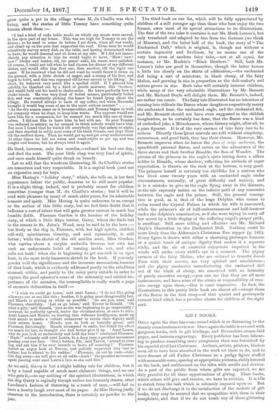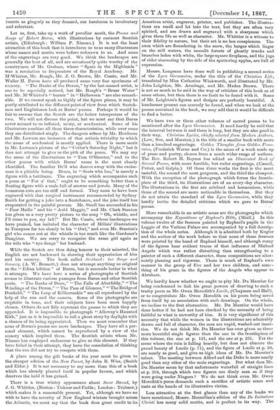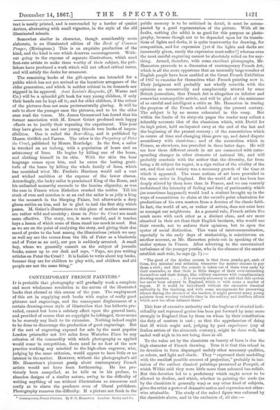GIFT BOOKS.
ONCE again the time has come round which is so distressing to the sternly conscientious reviewer. Once again the table is covered with gorgeous books, rich in gilt bindings, and Devonshire-cream-laid paper, and lustrous engravings. Every publisher has been labour- ing to produce something more sumptuous than was furnished by his especial rival last Christmas. Authors, artists, printers, binders seem all to have been absorbed in the work set them to do, and to have dreamt of old Father Christmas as a pudgy figure stuffed with seasonable verse, opening at appropriate pictures, richly lettered on the back, and emblazoned on the sides with scrolls and devices. As a part of the public from whom gifts are expected, we fire duly grateful for all these opportunities of giving. These books, which others will give and receive, we have to criticize. It is idle to shrink from the task which is solemnly imposed upon us. But if we do not discharge it to the satisfaction of the makers of gift books, they may be assured that we sympathize with them in their complaints, and that if we do not touch any of these glittering
insects as gingerly as they demand, our harshness is involuntary and reluctant.
Let us, first, take up a work of peculiar merit, the Poems and Songs of Robert Burns, with illustrations by eminent Scottish artists, (Edinburgh : William P. Nimmo.) It is not the least attraction of this book that it introduces us to so many illustrators whose names and merits were before unknown to us. And some of the engravings are very good. We think the landscapes are generally the best of all, and are occasionally quite worthy of the countrymen of Mr. Graham, whose "Spate in the Highlands" was a revelation to frequenters of the Royal Academy. Mr. M‘Whirter, Mr. Bough, Mr. J. 0. Brown, Mr. Cassie, and Mr. Waller H. Paton have all produced some very fine specimens of scenery. "The Banks of the Devon," by the last-named artist, is one to be especially noticed, but Mr. Bough's " Bruer Water" and Mr. M‘Whirter's " burnie " in "Halloween "are also remark- able. If we cannot speak so highly of the figure pieces, it may be partly attributed to the different point of view from which Scotch- men and Englishmen look at Burns' poems. Perhaps it would be fair to assume that the Scotch are the better interpreters of the two. We will not discuss the point, but we must say that Burns never seemed to us inflated, misty, or academical. Some of his illustrators combine all these three characteristics, while over some they are distributed singly. The dungeon scenes by Mr. Herdman and Mr. Lawson are instances of that artistic triviality to which the name of academical is mostly applied. There is more merit in Mr. Lawaon's picture of the "Cotter's Saturday Night," but it does not attempt to give us the pith of the poem. We may say the same of the illustrations to "Tam O'Shanter," and to the other poems with which Burns' name is the most closely identified. The familiar De'il who dances away with the excise- man is a pitiable being. Bruce, in "Scots wha hae," is merely a figure with a battleaxe. The engraving which accompanies such a poem as "For a' that," ought to be something better than a floating figure with a scale full of crowns and jewels. Many of the humorous cuts are too stiff and formal. They seem to have been engraved with that surgical instrument recommended by Sydney Smith for getting a joke into a Scotchman, and the joke itself has evaporated in the painful process. Mr. Steel has succeeded* his "Poor Alailie " and his "Auld niggie," and-Mr. Clark Stanton has given us a very pretty picture to the song "Oh, whistle, and I'll come to you, my lad!" But Mr. Cassie, whose landscapes we have praised, has imitated the character of Millais' illustrations to Tennyson far too closely in his "Owl," and even Mr. Stanton's girl who comes out at the whistle is too much like the Gardener's Daughter. We are sorry to recognize the same girl again as the wife who "aye clangs" her husband.
While the Scotch are thus doing honour to their minstrel, the English are not backward in showing their appreciation of him and his country. The book called Scotland: her Songs and Scenery, (A. W. Bennett,) does not attempt anything so original as the "Edina *edition" of Burns, but it succeeds better in what it attempts. We have here a series of photographs of Scottish scenes to illustrate various passages from Burns and other Scottish poets. "The Banks of Doon," "The Falls of Aberfeldy," "The Windings of the Devon," "The Pass of Glencoe," "The Bridge of Dunkeld," "The Leap of Killiecrankie " are all reproduced by the help of the sun and the camera. Some of the photographs are exquisite in tone, and their subjects have been most happily chosen. Others do not fitly represent the poems to which they are appended. It is impossible to photograph " Alloway's Haunted Kirk," just as it is impossible to tell a ghost story by daylight with a chance of its being appreciated. Then we must remember that none of Burns's poems are mere landscapes. They have all a per- sonal element, which cannot be reproduced by a view of the scenery which inspired them. The Scottish artists whom Mr. Nimmo has employed endeavour to give us this element. If they have failed in their attempt, they have the consolation of thinking that the sun did not try to compete with them.
A place among the gift books of the year must be given to the cheaper edition of the New Forest, by John R. Wise, (Smith and Elder.) It is not necessary to say more than this of a book whiCh has already planted itself in popular favour, and which deserves the hold it has gained.
There is a true wintry appearance about Snow Bound, by J. G. Whittier, (Boston : Ticknor and Fields ; London : Triibner,) which makes it a seasonable present. Yet, although we have no wish to have the severity of New England winters brought across the Atlantic, we must say that the book does great credit to its
American artist, engraver, printer, and publisher. The illustra- tions are small and let into the text, but they are often very spirited, and are drawn and engraved with a sharpness which gives them life AS well as character. Mr. Whittier is a witness to their fidelity to nature, but their art is no legs conspicuous. The oxen which are floundering in the snow, the barges which linger on the still waters, the moonlit forests of ghostly trunks and branches laden with white, the large square fireplaces, and the jugs. of cider simmering by the side of the sputtering apples, are full of expression.
Messrs. Longman have done well in publishing a second series of the Lyra Germanica, under the title of the Christian Life, translated by Miss Catherine Winkworth, and illustrated by Mr. John Leighton, Mr. Armitage, and Mr. Madox Brown. There is not so much to be said in the way of criticism of this book as of some others, but then there is no fault to be found with it. Some of Mr. Leighton's figures and designs are perfectly beautiful. A handsomer present can scarcely be found, and when we look at the poems contained in the book, we may add that it would be difficult to find a better.
We have two or three other volumes of sacred poems to be mentioned after the Lyra Germanica. It need hardly be said that the interval between it and them is long, but they are also good*, their way. Christian Lyrics, chiefly selected from Modern Authors, (Low, Son, and Marston,) is the title of a smaller book with more- than a huudred engravings. Golden Thoughts from Golden Foun- tains, (Frederick Warne and Co.) is the name of a work made up of prose and poetry, chosen from a much wider range of authors. The Rev. Robert H. Baynes has edited an Illustrated Book of Sacred Poems, with more forcible, but ruder engravings, (Cassell, Petter, and Galpin.) Of these three works the first is the most tasteful, the second the most gorgeous, and the third the cheapest Withthe exception of the photograph which forms the frontis- piece of the third, its illustrations are of an every-day character. The illustrations in the first are subdued and harmonious, while- those of the second are more noticeable in themselves. But they
not attain the standard of the Lyra Gernianica, while they hardly invite the detailed criticism which we gave to Burns" poems. - More remarkable in an artistic sense are the photographs which accompany the Expositions of Raphael's Bible, (Miall.) In this volume twelve of the frescoes painted by Raphael's pupils in the Loggie of the Vatican Palace are accompanied by a full descrip- tion of the whole series. Although it is admitted both by Kugler- and the author of the work before us that none of these frescoes were painted by the hand of Raphael himself, and although many of the figures bear evident traces of that influence of Michael Angelo which was rather disturbing than strengthening to a painter of such a different character, these compositions are alter- nately pleasing and vigorous. There is much of Raphael's own manner in the group of Eve and her two children, and some- thing of his grace in the figures of the Angels who appear to Abraham.
We hardly know whether we ought to pity Mr. Du Maurier for being condemned to link his great powers of drawing to such a trashy poem as Mr. Owen Meredith's Lucile, (Chapman and Hall), or to congratulate Mr. Owen Meredith on his poem being saved from itself by an association with such drawings. On the whole, we incline to the first alternative. Mr. Du Maurier would have done better if he had not been checked by the necessity of being faithful to what is unworthy of him. It is very significant of this necessity that while the women in the illustrations are admirably drawn and full of character, the men are vapid, washed-out inani- ties. We do not think Mr. Du Maurier has ever given us three more beautiful single figures than the one in the frontispiece of this volume, the one at p. 121, and the one at p. 231. Yet the scene where the rain is falling heavily, but does not obscure the proud beauty of Lucile (p. 71), and the figure of Lucile at p. 58, are nearly as good, and give us high ideas of Mr. Du Manner's talent. The meeting between Alfred and the Duke is more nearly good than any other of the male engravings. But what does Mr. Du Meatier mean by that unfortunate waterfall of straight lines at p. 204, through which two figures are dimly seen as if they were going under Niagara ? We do not think even Mr. Owen -Meredith's poem demands such a sacrifice of artistic sense and taste at the hands of its illustrative victim.
Less attractive at the first glance than any of the books we have mentioned, Messrs. Macmillan's edition of the De Imitations Christi has many solid merits, and is perfect in its way. The text is neatly printed, and is surrounded by a border of quaint devices, alternating with small vignettes, in the style of the old illuminated missals.
Somewhat similar in character, though considerably more elaborate, is an illuminated edition of the Book of Common Prayer, (Rivingtons.) This is an exquisite production of the kind, and the kind is one which deserves encouragement. With- out going to the expense of separate illustrations, which need first-rate artists to make them worthy of their subject, the pub- lishers have produced a work which will not offend critical tastes, and will satisfy the desire for ornament.
The remaining books of the gift-species are intended for a public which has not yet arrived at the luxurious arrogance of the older generation, and which is neither critical in its demands nor niggard in its approval. Aunt Louisa's Keepsake, (F. Warne and Co.) will be a splendid gift book for very young children, if only their hands can be kept off it; and for older children, if the colour of the pictures does not seem preternaturally glaring. It will be safe to show the younger ones the pictures, and to let the older ones read the verses. Mr. James Greenwood has found that his former association with M. Ernest Griset produced such happy effects as to justify their repeating the experiment. This year they have given us and our young friends two books of impos- sibilities. One is called the Bear-King, and is published by Messrs. Griffith and Ferran. The other is the Purgatory of Peter the Cruel, published by Messrs. Routledge. In the first, a sailor is wrecked on an iceberg, with a population of bears and an aristocracy of lions. He begins by killing one of the bears, and clothing himself in its skin. With the skin the bear language comes upon him, and he earns the lasting grati- tude of the bears by killing the whole family of lions, which has nourished what Mr. Frederic Harrison would call a vast and wicked ambition at the expense of the lower classes. Accordingly, the lucky sailor is proclaimed King of the Bears, and his unlimited monarchy succeeds to the leonine oligarchy, as was the case in France when Richelieu crushed the nobles. Till his stock of rum and matches is at an end the sailor is as jolly a king as the monarch in the Sleeping Palace, but afterwards a deep gloom settles on him, and he is glad to hail the first ship which paws. M. Onset's illustrations to this piece of marine assurance are rather wild and scratchy ; those in Peter the Cruel are much more effective. The story, too, is more careful, and it teaches boys a lesson of which some of them stand too much in need. But as we are on the point of analyzing the story, and giving their due meed of praise to the best among the illustrations (which we may as well say are the scenes from the life of Peter as a bluebottle and of Peter as an ant), our pen is suddenly arrested. A small boy, whom we generally consult on the subject of juvenile books, comes up to our desk an' d says, "Papa, are you writing articles on Peter the Cruel? It is foolish to write about toy books, because they are for children to play with, and children and old people are not the same thing."








































 Previous page
Previous page